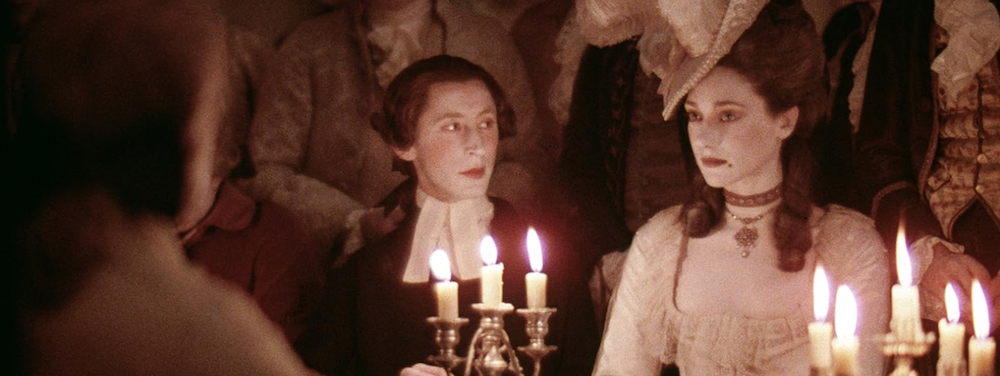Barry Lyndon (1975) Warner Bros.
This event was scheduled June 21-23, 2024.
Stanley Kubrick’s masterful Barry Lyndon comes to the Palm Theatre June 21-23, offering viewers a chance to enjoy this ravishing masterpiece the way it was meant to be shown—on a theatre screen.
By the early 1970s, Stanley Kubrick had directed three consecutive cinematic landmarks that had vastly different themes and styles: Dr. Strangelove (1964); 2001: A Space Odyssey (1968); and A Clockwork Orange (1971). So for Kubrick, one of cinema’s most original and innovative directors, what came next after his up-to-the-minute black comedy, his science-fiction milestone marking the turn of the next century, and his savage satire set in a violent near-future?
Surprisingly, a stately 18th-century costume drama.
Kubrick’s 1975 movie was based on William Makepeace Thackeray’s 1844 novel about the rise and fall of an unprincipled young Irishman in the 1700s. Not only was the historical setting a bold departure for Kubrick, but Barry Lyndon was a radical movie in an era when Hollywood was telling modern stories; consider that year’s other Best Picture Oscar nominees besides Barry Lyndon: Jaws, Dog Day Afternoon, One Flew Over the Cuckoo’s Nest, and Nashville.
Patient audiences who are willing to invest time and attention, however, are rewarded with ground-breaking visual splendor.”
Critics recognized Kubrick’s cinematic achievement and fully embraced Barry Lyndon, awarding it many prestigious honors and nominating it for seven Oscars, including Best Picture and Best Director. It won for its cinematography, art direction, costumes, and music. Today it routinely makes top-100 lists of the all-time best movies.
Audiences at the time were a little less enthusiastic for what many perceived as a challenging experience. Many viewers were wary of the movie’s extreme length (184 minutes) and its deliberate pace. While there are several army battles and four one-on-one duels in Barry Lyndon, many scenes leisurely unfold in slow-motion, with seemingly little action and barely any dialogue (shades of 2001).
Tellingly, MAD magazine (September 1976) spoofed the movie as “Borey Lyndon.”
Patient audiences who are willing to invest time and attention, however, are rewarded with ground-breaking visual splendor. For his long, languid story, Kubrick introduced cutting-edge filming techniques to create one of the most gorgeous movies ever made.
Pairing John Alcott’s Oscar-winning cinematography with special new lenses designed for NASA, Kubrick was able to capture quiet, intimate scenes lit only by candles, making viewers feel like they really are sitting inside an elegant Georgian mansion at night.
This is a spectacle best appreciated on a big theatre screen.”
What’s more, Kubrick took inspiration for his spectacular panoramic landscapes from actual paintings; it’s possible to match up some of his shots with specific works by Gainsborough, Hogarth, and other masters. Sumptuous settings, meticulous historical details, authentic costumes, and lavish wigs, all backed by the century’s greatest composers (Bach, Vivaldi, Handel, etc.), make Barry Lyndon more art than movie.
This is a spectacle best appreciated on a big theatre screen.
Kubrick departed from the novel in several ways, most notably by not having the rakish Redmond Barry tell his own story. In Thackeray’s book, Barry’s first-person narration is often unreliable and satirical. Instead, Kubrick has an omniscient narrator add subdued commentary and information, and the movie becomes less farcical and more tragic as a result.
To help him tell his story, Kubrick brought back several familiar actors from his previous films, including Leonard Rossiter (2001) and Patrick Magee (A Clockwork Orange), as well as key crewmembers.
Kubrick’s most controversial decision was to cast Ryan O’Neal as the lead. O’Neal plays the handsome scoundrel Redmond Barry, “born,” the narrator says, “clever enough at gaining a fortune, but incapable of keeping one.”
In Part I we meet this “boy,” “schoolboy,” “meddling brat,” “lad,” and “poor child” as he begins his rise from a meager upbringing and anonymity in Ireland to war-time adventures across Europe and finally to wealth and notoriety in England some 30 years later. The miscast O’Neal, famous (and Oscar-nominated) as the preppie college student in Love Story (1970), is 34 years old for all of these scenes that take him from naïve youth to mature dissolution, all while speaking in an inconsistent Irish accent.
O’Neal’s restrained expressions keep him as stiff as one of the people in those 18-century paintings Kubrick is depicting.”
Even worse, O’Neal shows the same wooden expression for the first 40 minutes, finally half-smiling when he wins a fistfight. Throughout the movie he’s usually about as expressive as the humorless astronauts in 2001, who were intentionally downplaying their reactions to underscore their cool professionalism. Here, O’Neal’s restrained expressions keep him as stiff as one of the people in those 18-century paintings Kubrick is depicting.
After 92 minutes, Redmond Barry meets his springboard to high society, the Countess of Lyndon (Marisa Berenson), “a woman of vast wealth and great beauty.” Berenson is indeed gorgeous, but her character rarely talks, and for all the emotion she’s asked to display, the part could be played by a beautiful mannequin.
Barry and Lady Lyndon’s sad married life fills the more melodramatic Part II, “an account of the misfortunes and disasters which befell Barry Lyndon.” Unfaithful, profligate, and eventually an alcoholic, Redmond is doomed to “finish his life poor, lonely, and childless,” especially after his beloved son dies tragically and his angry stepson shoots him in the last of the movie’s duels.
In our final look at Redmond, he’s pathetically limping away on one leg to become an unsuccessful gambler who will never see Lady Lyndon or England again.
Barry Lyndon is a movie by and for sophisticated grown-ups who love the classics and a good museum.
Editor’s Note: See David Congalton’s review of Chris Strodder’s new book, What’s Wrong With This Best Picture?
